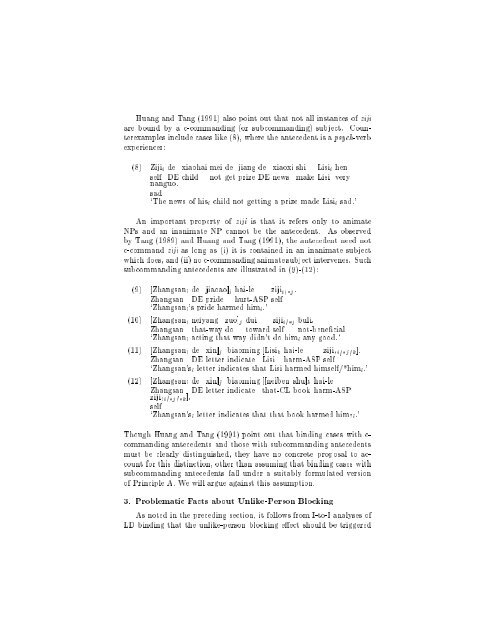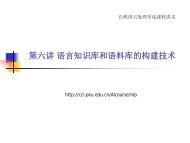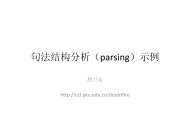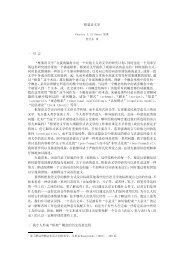A New Perspective On Chinese ZIJI
A New Perspective On Chinese ZIJI
A New Perspective On Chinese ZIJI
Create successful ePaper yourself
Turn your PDF publications into a flip-book with our unique Google optimized e-Paper software.
Huang and Tang (1991) also point out that not all instances of ziji<br />
are bound by a c-commanding (or subcommanding) subject. Counterexamples<br />
include cases like (8), where the antecedent isapsych-verb<br />
experiencer:<br />
(8) Zijii de xiaohai mei de jiang de xiaoxi shi Lisii hen<br />
self DE child not get prize DE news make Lisi very<br />
nanguo.<br />
sad<br />
`The news of his i child not getting a prize made Lisi i sad.'<br />
An important property of ziji is that it refers only to animate<br />
NPs and an inanimate NP cannot be the antecedent. As observed<br />
by Tang (1989) and Huang and Tang (1991), the antecedent neednot<br />
c-command ziji as long as (i) it is contained in an inanimate subject<br />
which does, and (ii) no c-commanding animate subject intervenes. Such<br />
subcommanding antecedents are illustrated in (9)-(12):<br />
(9) [Zhangsani de jiaoao] j hai-le zijii= j.<br />
Zhangsan DE pride hurt-ASP self<br />
`Zhangsani's pride harmed himi.' (10) [Zhangsani neiyang zuo] j dui<br />
Zhangsan that-way do toward self<br />
ziji i= j<br />
buli.<br />
not-bene cial<br />
`Zhangsan i acting that way didn't do him i any good.'<br />
(11) [Zhangsani de xin] j biaoming [Lisik hai-le ziji i= j=k].<br />
Zhangsan DE letter indicate Lisi harm-ASP self<br />
`Zhangsan'si letter indicates that Lisi harmed himself/*himi.' (12) [Zhangsani de xin] j biaoming [[neiben shu] k hai-le<br />
Zhangsan DE letter indicate<br />
ziji ?i= j= k].<br />
self<br />
that-CL book harm-ASP<br />
`Zhangsan'si letter indicates that that book harmed him?i.'<br />
Though Huang and Tang (1991) point out that binding cases with ccommanding<br />
antecedents and those with subcommanding antecedents<br />
must be clearly distinguished, they have no concrete proposal to account<br />
for this distinction, other than assuming that binding cases with<br />
subcommanding antecedents fall under a suitably formulated version<br />
of Principle A. We will argue against this assumption.<br />
3. Problematic Facts about Unlike-Person Blocking<br />
As noted in the preceding section, it follows from I-to-I analyses of<br />
LD binding that the unlike-person blocking e ect should be triggered
















